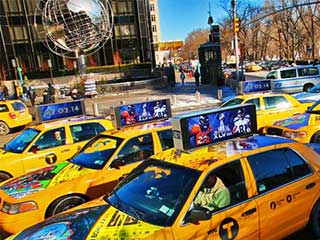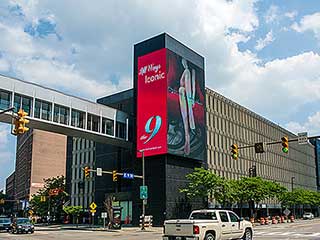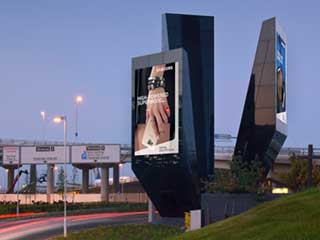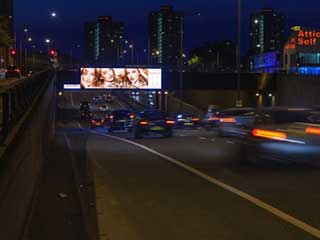DOOH Globalizing: Tendencies in Digital Advertising
The analysts agree that the future of advertising is in the digital format. But when will this future finally arrive? The Out of Home (OOH) market sector currently sits on a launch pad. New applications appear, the prices for video screens drop regularly, digital advertising becomes affordable for small business, but the launch is postponed. All this happens on the background of the world economic crisis. In these conditions advertising could be expected to suffer first. But advertising seems to be very adaptive and resilient.
 |
 |
| JCDecaux digital billboard at Liverpool Street Station in London | London King’s Cross railway station digital displays |
A 2011 study by Markets and Markets Analysis and Global Industry Analysts estimated that the global digital signage systems market would reach $13.2 billion by 2016. Researchers said a retail boom in countries such as China, Singapore, Malaysia and Thailand, the United Arab Emirates, Hong Kong and India would help the lead the way. The United States is the largest regional market worldwide; Asia-Pacific the fastest-growing. The growth rate is determined by manufacturing indices and sales of public screens. Only in the USA, from 3 million in 2013 this figure keeps moving up and by 2018 is conservatively estimated to reach 12 million.
 |
 |
| Taxi top LED digital signage | New large LED display in Cleveland (USA) |
This means that sales of LCD and PDP (public screens only) will grow at least four times globally. The estimate of the Digital Signage world market apart from displays includes also media players, content servers, hardware for video signal transfer and distribution, software etc. As sales grow, it becomes possible to evaluate those spheres where informational and advertising systems are in the greatest demand. Today these are mostly in-store and transit media.
According to Outdoor Media Centre, the European OOH market shows healthy and optimistic 6.4% growth in the second quarter 2014. Moreover the research conducted by Future Foundation for FEPE International revealed that only 28% of consumers consider TV advertising as trustworthy; 24% put their trust in OOH advertising and 22% in printed media. The shockingly low 3% think about Internet-based advertising as reliable.
In spite of the politically turbulent times, Russian advertising also feels confidently. According to ZenithOptimedia Group Russia, the total growth rate is currently at 5.3% (this is lower than expected last year, but is still considered an excellent result). What is especially encouraging is that outdoor advertising grew faster than other sectors of advertising market. This is all good news for such major players as JCDecaux, Clear Channel, Ocean Outdoor, Primesight, Vi (former Video International) or Russ Outdoor.
What can be done for the industry to maintain growth and achieve a bigger slice of the advertising pie? Some analysts believe that the answer lies in collaboration between all advertising market participants. For years, individual players have struggled, innovated internally and embraced aspects, such as digital and interactive OOH at different rates and in different ways. Overall, it’s been a highly fragmented approach. Now there is a general call to come together, pool collective resources and offer both advertisers and consumers a more intelligent form of advertising. Incidentally, this coincides with the general trend of market consolidation, business growth, takeovers and forming of international alliances.
 |
 |
| JCDecaux three-sided LED digital tower of Heathrow Terminal 2 | New Outdoor Plus LED screen in London on the A12 |
Only large corporations with unlimited resources can afford to build new extensive OOH networks, set up data centers and offer their cloud services to smaller companies, integrate fragmented advertising budgets. Smaller companies are forced to use outsourced cloud services and thus lose their independence and even client base. The fragmented market is inconvenient for federal regulators but is an indispensable part of the free market economy. However under the auspices of collaboration it is easy to promote ideas of consolidation and mergers.
The merger in the advertising sphere is not the only tendency that is observed by experts who together with us follow the situation in the market closely.
- LCD display expansion into outdoor markets. The new generation high-brightness LCD panels with LED backlight are being actively installed in the public transit sphere – airports, metro, and land public transport. Significant weight reduction in modern panels, lower energy consumption, absence of air conditioning, possibility of operation behind the protective glass outdoors (for instance, on transit booths) turns LCD panels into a serious competitor to LED screens with low pitch.
- Using high-definition formats, including the new 4K for digital advertising. It is obvious that 4K is excessive for outdoor applications but since more and more video clips are made in this new format, it makes sense to install matching displays. As soon as the price on 4K displays goes down, they will inevitably become displays of choice in outdoor. Unlike 3D that is useless in outdoor applications, 4K has good chances to turn out the leader.
- Timid attempts to use data-driven targeted marketing in OOH. Data collection and analysis as well as context advertising have long been adopted in the Internet. But these methods were not implemented in OOH, though as the technology of image recognition matures, it becomes quite realistic to adapt advertising message on in-store screens and even outdoors depending on the audience.
- Live video feeds into advertising blocks. Consumers get used to screen-based advertising and therefore advertisers are constantly experimenting with new formats and contents, the most promising and effective being inclusion of live video that draws consumers to displays.
- Using personal mobile IT devices as an extension of interactive digital signage. We are all constantly moving, rushing from place to place. The moment a person stops, his eyes are automatically glued to the screen of his favorite smartphone or tablet. Today there is a real possibility to add these personal devices to a chain of interactive advertising outdoor solutions: digital kiosks, signs, in-store LCDs. This is one more method for business to attract the attention of a potential customer.
- Interactive digital signage. Someone working in the advertising sphere once made a joke: Digital signage without interactive functions is like a TV without remote. Digital screens today acquire new functions almost daily: they now react to the touch, gesture, voice etc. Probably the time will come when they learn to feel what our mood is and offer the products correspondingly.
- Vending machines become intelligent. Vending machines gradually expand their presence on the retail market. As new generation machines turn into real hi-tech devices with capabilities of digital outdoor advertising screens, touch-screen interactive technology, cashless payment systems, mobile interaction, and telemetry for remote data collection, etc. Developers of specialized software and applications on anonymous video analytics believe that this is just a beginning.
Naturally, these innovations and tendencies cannot fully describe the situation on the advertising outdoor market. We only tried to outline the most interesting trends.





